NGC 5050
Appearance
From Wikipedia, the free encyclopedia
Lenticular galaxy in the constellation Virgo
| NGC 5050 | |
|---|---|
 NGC5050 - SDSS DR14. | |
| Observation data (J2000 epoch) | |
| Constellation | Virgo |
| Right ascension | 13h 15m 41s[1] |
| Declination | +02° 52′ 44″[1] |
| Redshift | 0.0197[1] |
| Distance | 271 Mly[1] |
| Characteristics | |
| Type | S0-a[1] |
| Apparent size (V) | 1.1′ × 24′[1] |
| Other designations | |
| CGCG 44-43, MCG 1-34-12, PGC 46138, UGC 8329. | |
NGC 5050 is a lenticular galaxy in the constellation Virgo. It was discovered by a German astronomer Albert Marth on April 30, 1864.[2] It is also known as CGCG 44-43, MCG 1-34-12, PGC 46138, UGC 8329.[1]
Marth discovered it in Malta with the help of Lassel's 48" reflector.[3] It is faint, small and stellar with an apparent magnitude of 1.4.[2]
See also
[edit]References
[edit]- ^ a b c d e f g "Galaxy NGC 5050 . Deep Sky Object Browser". Archived from the original on 2017-01-05. Retrieved 2017-01-04.
- ^ a b New General Catalogue Ojects: NNGC 5050-5099
- ^ Albert Marth
External links
[edit] Media related to NGC 5050 at Wikimedia Commons
Media related to NGC 5050 at Wikimedia Commons
Retrieved from "https://en.wikipedia.org/w/index.php?title=NGC_5050&oldid=1187316087"
